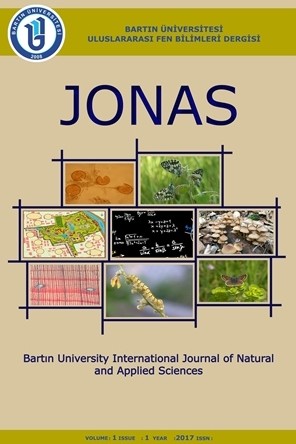KOMPOZİT ZIRH TASARIMI VE BALİSTİK DİRENCİNİN İNCELENMESİ
Zırh sistemi, balistik test, lamine kompozit
DESIGN OF A COMPOSITE ARMOR AND INVESTIGATION OF ITS BALLISTIC RESISTANCE
Armor system, ballistic test, laminated composite,
___
- 1. Arslan, M., Karimzadehkhoei, M., Sireli, G.K., Coskun, O.K., Sert, M. & Timur, S. (2022). Investigating Growth of Iron Borides with the Formation of Monolithic Fe2B Layer on AISI 304 Stainless Steel via Cathodic Reduction and Thermal Diffusion-Based Boriding. Journal of Materials Engineering and Performance, 31(4), 3274-3286.
- 2. Arteaga-Hernandez, L.A., Cuao-Moreu, C.A., Gonzalez-Rivera, C.E., Alvarez-Vera, M., Ortega-Saenz, J.A. & Hernandez-Rodriguez, M.A.L. (2021). Study of boriding surface treatment in the tribological behavior of an AISI 316L stainless steel. Wear, 477, 203825.
- 3. Ash, R.A. (2016). Vehicle Armor. Lightweight Ballistic Composites: Military and Law-Enforcement Applications. Elsevier Ltd., Woodhead Publishing, New York.
- 4. Başaran, B. (2007). Computational Analysis Of Advanced Composite Armor Systems (Master's thesis, Orta Doğu Teknik Üniversitesi).
- 5. Bitlisli, B. (2019). Zırhlı Araçlarda Kullanılan Kompozit Zırh Malzemelerinin Balistik Performanslarının İncelenmesi (Master's thesis, Bursa Uludağ Üniversitesi).
- 6. Campos-Silva, I., Hernández-Ramirez, E.J., Contreras-Hernández, A., Rosales-Lopez, J.L., Valdez-Zayas, E., Mejía-Caballero, I. & Martínez-Trinidad J. (2021). Pulsed-DC powder-pack boriding: Growth kinetics of boride layers on an AISI 316 L stainless steel and Inconel 718 superalloy. Surface and Coatings Technology, 421, 127404.
- 7. Candan, C. (2005). Zırh Teknolojilerindeki Gelişmeler. Zırh Teknolojileri Semineri, 10-11 Mart, Ankara, Milli Savunma Bakanlığı Arge ve Teknoloji D. Bşk.lığı
- 8. Carlucci, D.E. & Jacobson, S.S. (2008). Ballistics: Theory and Design of Guns and Ammunition. CRC Press. p. 310. ISBN 978-1-4200-6618-0.
- 9. Demircioğlu, T.K., Candan, C. & Kasım, İ.A. (2011). Organik Matrisli Kompozit Malzeme Kullanılarak Oluşturulan Hibrit Zırh Plakasının Terminal Balistik Özelliklerinin İncelenmesi. I. Ulusal Ege Kompozit Malzemeler Sempozyumu, 17-19 Kasım, İzmir.
- 10. Fernández-Fdz, D. & Zaera, D. (2008). A New Tool Based on Artificial Neural Networks for the Design of Lightweight Ceramic–Metal Armour Against High-Velocity Impact of Solids. International Journal of Solids and Structures, 45, 6369-6383.
- 11. Flores-Johnson, E.A. & Saleh, M. & Edwards, L. (2011). Ballistic performance of multi-layered metallic plates impacted by a 7.62-mm APM2 projectile. International Journal of Impact Engineering, 38(12), 1022-1032.
- 12. Gençer, Y. (2016). Zırh Malzemesi Olarak Borür/Metal Tabakalı Kompozitlerin Üretilmesi ve Karakterizasyonu. Tübitak projesi, Proje No. 213M166.
- 13. Günen, A., Kurt, B., Orhan, N. & Kanca, E. (2014). The investigation of corrosion behavior of borided AISI 304 austenitic stainless steel with nanoboron powder. Protection of Metals and Physical Chemistry of Surfaces, 50(1), 104-110.
- 14. Güneş, R. (2015). Fonksiyonel Kademelendirilmiş Sandviç Plakaların Balistik Darbe Etkisi Altında Lineer Olmayan Mekanik Analizleri. Tübitak projesi, Proje No: 112M917.
- 15. Hazell, P.J. (2016). Armour Materials, Theory and Design (First Edition). CRC Press, Taylor & Francis Group, New York.
- 16. Jinzhu, L., Liansheng, Z. & Fenglei, H. (2017). Experiments and Simulations of Tungsten Alloy Rods Penetrating into Alumina Ceramic/603 Armor Steel Composite Targets. Int. Journal of Impact Engineering, 101, 1-8.
- 17. Kayali, Y., Büyüksağiş, A. Güneş, I. & Yalçin, Y. (2013). Investigation of corrosion behaviors at different solutions of boronized AISI 316L stainless steel. Protection of Metals and Physical Chemistry of Surfaces, 49(3), 348-358.
- 18. Lo´pez-Puente, J., Arias, A., Zaera, R. & Navarro, C. (2005). The effect of the thickness of the adhesive layer on the ballistic limit of ceramic/metal armours. An experimental and numerical study. International Journal of Impact Engineering, 32, 321–336.
- 19. Medvedovski, E. (2010). Ballistic performance of armour ceramics: Influence of design and structure. Part 1. Ceramics International, 36 (7), 2103-2115.
- 20. Meyers, M.A. (1994). Dynamic Behavior of Materials. John Wiley & Sons Inc, New York, pp. 597.
- 21. Rahman, N.A., Abdullah, S., Zamri, W.F.H., Abdullah, M.F., Omar, M.Z. & Sajuri Z. (2016). Ballistic Limit of High-Strength Steel and Al7075-T6 Multi-Layered Plates Under 7.62-mm Armour Piercing Projectile Impact. Latin American Journal of Solids and Structures, 13, 1658-1676.
- 22. URL-1, (2020). https://ayam.com.tr/arastirma/turkiyede-son-5-yilda-yasanan-gelismeler-savunma-sanayi-2015-2020/”
- 23. Übeyli, M., Yıldırım, R.O. & Ögel, B. (2007). On the comparison of the ballistic performance of steel and laminated composite armor. Materials and Design, 28, 1257–1262.
- 24. Übeyli, M., Deniz, H., Demir, T., Ögel, B., Gürel, B. & Keleş, Ö. (2011). Ballistic impact performance of an armor material consisting of alümina and dual phase steel layers. Materials & Design, 32 (3), 1565-1570.
- 25. Ünaler, E. (2005). Development And Characterization Of Light-Weight Armor Materials (Master's thesis, İzmir İleri teknoloji Enstitüsü).
- 26. Ziylan, A. (2001). Savunma Nereden Nereye Türkiye’de Savunma Sanayii Tarihçesi. Ulusal Strateji Dergisi,1-7. https://www.inovasyon.org/images/makaleler/pdf/AZ.Savunma%20Nereden%20Nereye.pdf Son erişim tarihi: 20 Şubat 2023.
- Yayın Aralığı: Yılda 2 Sayı
- Başlangıç: 2017
- Yayıncı: Bartın Üniversitesi
STADYUMLARIN KENTTEKİ SOSYAL YAPILANMASININ TÜRKİYE AÇISINDAN DEĞERLENDİRİLMESİ
SYNTHESIS AND FUNCTIONAL PROPERTIES OF DIPHENYLAMINE-CONTAINING SCHIFF BASES
Hasan Ufuk CELEBİOGLU, Ebru KÖROĞLU, Recep TAŞ, Sevilay GÜNAY, Yavuz ERDEN
DOMATESTE BULUNAN KAROTENOİDLERDEN OLAN LİKOPENİN PROBİYOTİK BAKTERİLER İLE ETKİLEŞİMLERİ
Ebru KÖROĞLU, Hasan Ufuk CELEBİOGLU
KOMPOZİT ZIRH TASARIMI VE BALİSTİK DİRENCİNİN İNCELENMESİ
KENT SİMGESİ KÜLTÜR MERKEZLERİNİN GÖRSEL ALGI ANALİZİ
Özlem KAHRAMAN, Serhat ANIKTAR
PERFORMANCE OF BORON NITRIDE NANOSHEETS IN DYE ADSORPTION: A MINI-REVIEW
THE EFFECT OF PINE TREE RESIN ON THE THERMAL AND MECHANICAL PROPERTIES OF PLASTER WITH EXPANDED CLAY
COMPARATİVE ANALYSİS OF THE VİSUAL ELEMENTS OF TRADİTİONAL MOSQUES OVER MODERN MOSQUES
Esma KİŞMİROĞLU, Serhat ANIKTAR
